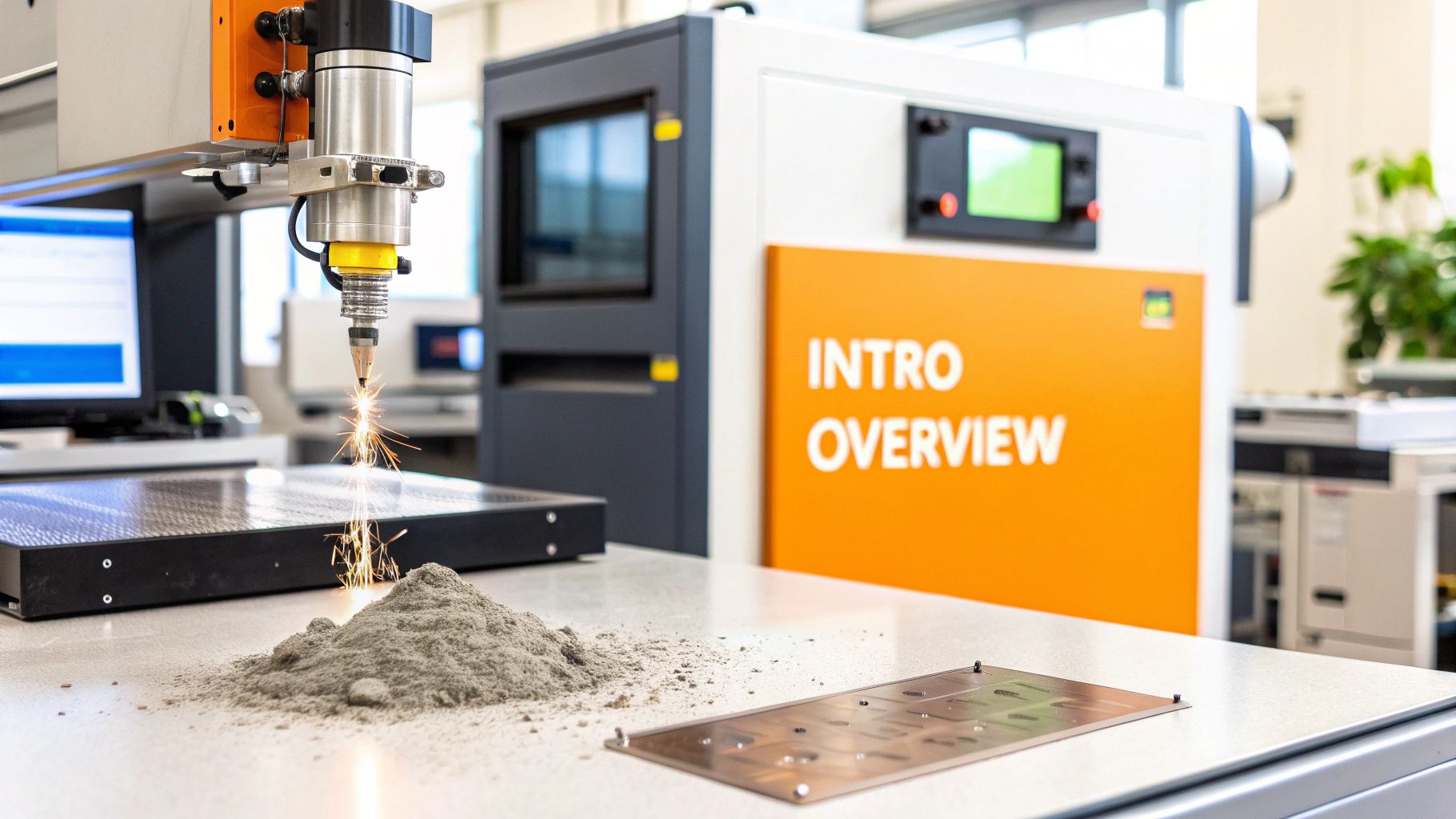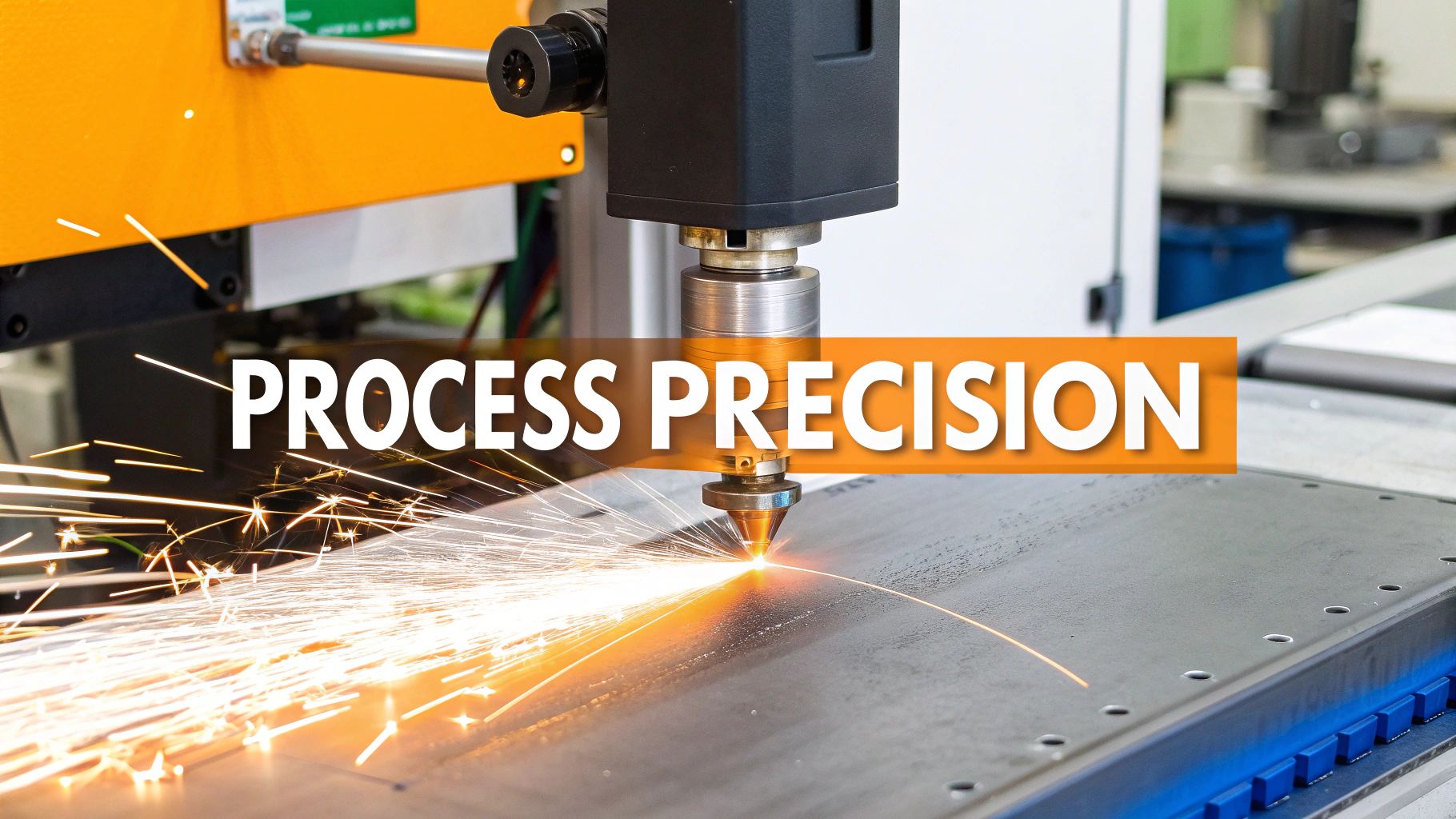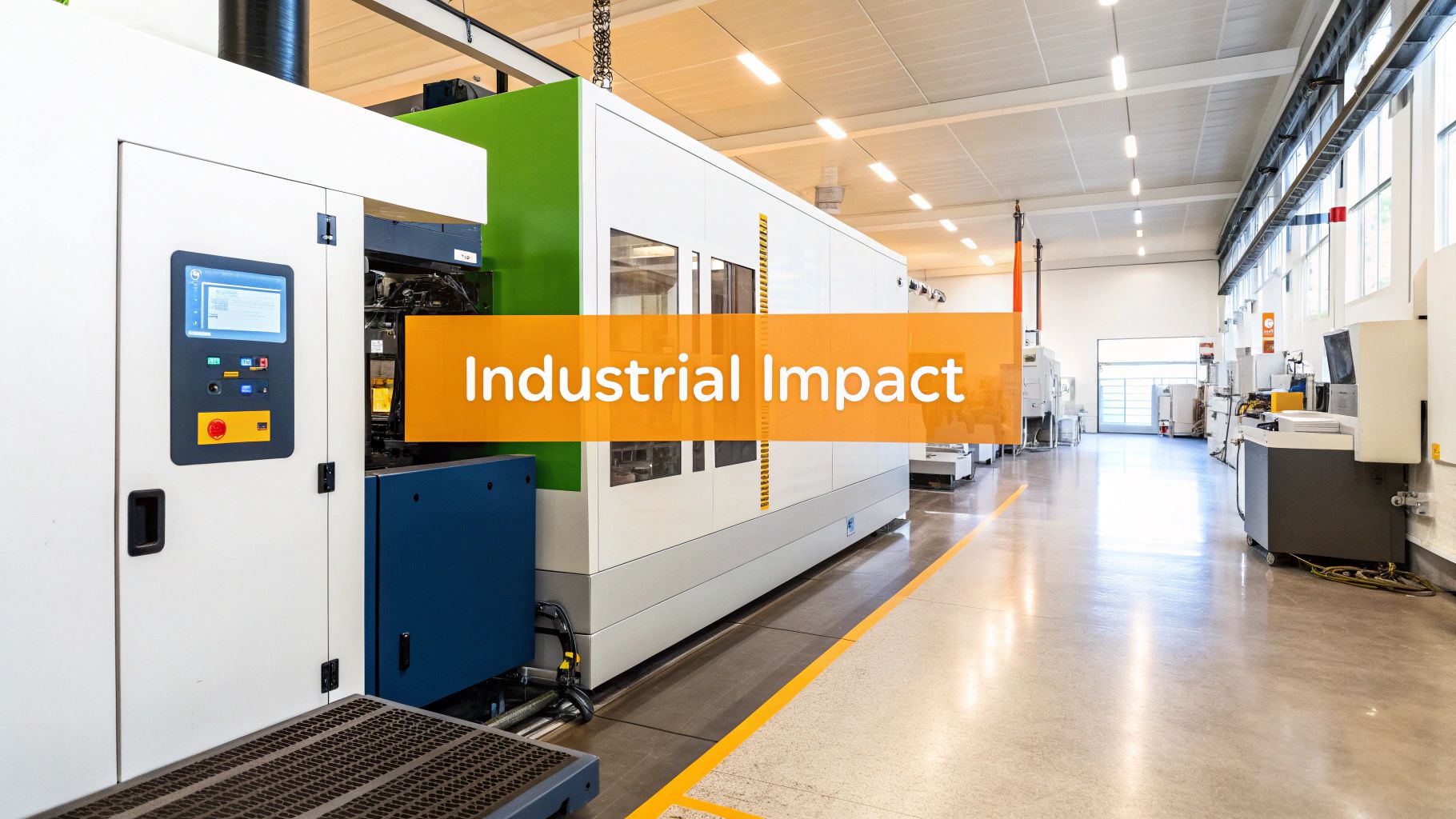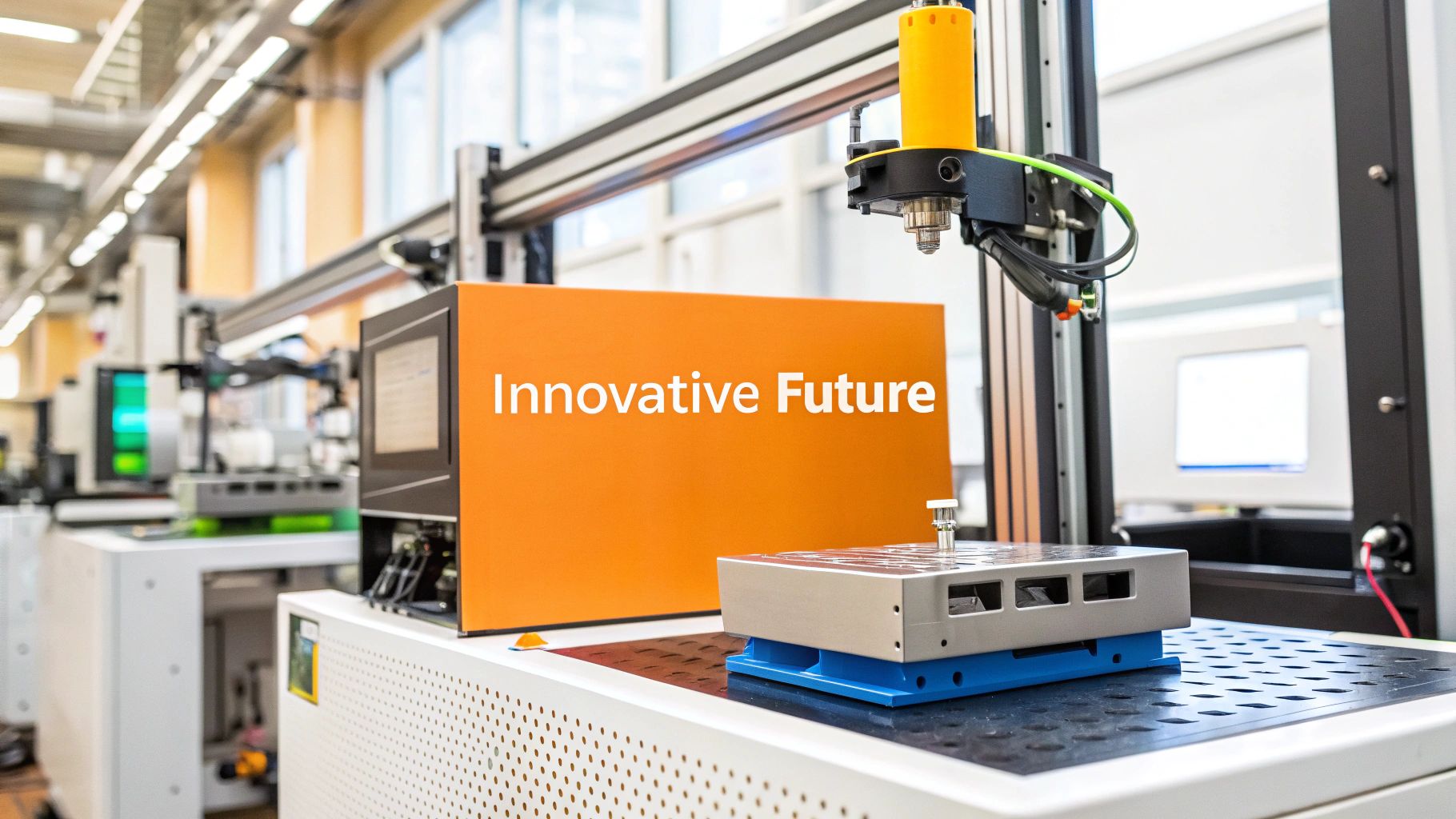The Evolution of Selective Laser Melting: From Concept to Production

Selective laser melting (SLM) creates intricate metal parts directly from digital designs, built layer by microscopic layer. It's a testament to how far additive manufacturing has come. But how did this technology evolve from a concept to a practical production method? The journey begins with its predecessor, selective laser sintering (SLS).
SLS uses a laser to sinter powdered materials, binding them together to form a solid. This provided the foundation for experimenting with metal powders. Early work with SLS offered the conceptual framework for using a laser to precisely melt and fuse metal particles.
This exploration led to the development of SLM, also known as direct metal laser sintering (DMLS), in the mid-1980s. The dream of creating fully dense metal parts layer by layer was becoming reality. This marked a key shift from sintering with lasers to actually melting the metal powders.
Overcoming Early Challenges
This leap forward wasn't easy. Early SLM systems struggled with controlling the laser's energy and achieving consistent melting. The limited selection of suitable metal powders also restricted the range of applications.
Persistent research and development at institutions like the Fraunhofer Institute and companies like EOS played a vital role. These pioneers pushed the boundaries of laser technology, powder metallurgy, and process control. They tackled difficult material science problems and refined the SLM process.
A Brief History of SLM
The evolution of SLM has been significantly influenced by advancements in laser technology, powder metallurgy, and control systems. Early progress was driven by breakthroughs at the Fraunhofer Institute and EOS.
SLM, also known as DMLS, has a rich history dating back to the mid-1980s. It evolved from SLS, patented by Carl Deckard and Dr. Joe Beaman. This early work led to the commercialization of SLS systems, such as the Sinterstation 2000 in 1992 and the EOSINT (P) 350 in 1994.
As technology progressed, German companies including EOS and the Fraunhofer Institute started developing metal printing solutions, specifically DMLS, in 1995. This marked the true beginning of SLM, with EOS and others pushing the boundaries of metal additive manufacturing.
Today, SLM is used globally in industries like aerospace, automotive, and healthcare. It's known for producing dense metal parts with high precision. Compared to traditional manufacturing, SLM offers significant reductions in material waste and production time for complex parts. Learn more about SLM technology here: Selective Laser Melting Technology
Key Milestones in SLM Development
- 1995: The emergence of DMLS marked the start of SLM as a distinct additive manufacturing process.
- Early 2000s: Advancements in machinery and materials propelled SLM into broader industrial use.
These milestones highlight the progress made in SLM technology, leading to its widespread adoption across various industries. SLM has evolved from an experimental concept into a powerful manufacturing tool. It produces complex metal components with incredible precision, continuing to shape the future of manufacturing by creating parts once impossible with traditional methods.
Inside the Selective Laser Melting Process: Making Metal Magic

Selective laser melting (SLM) is a powerful additive manufacturing process that transforms metal powder into intricate, fully dense parts. But what's the magic behind this technology? This section unveils the secrets of SLM, from the initial powder bed preparation to the finished product.
Preparing the Powder Bed
The journey begins with a thin layer of metal powder carefully spread across the build platform. A recoater blade meticulously levels this powder layer, ensuring its thickness is both uniform and precise, typically between 20 and 100 microns. This precision is paramount for achieving the desired accuracy in the final part. This initial powder bed serves as the foundation upon which the entire part will be built.
The Laser's Dance
Next, a high-powered laser beam comes into play. It scans across the powder bed, following a pre-determined path dictated by the digital design. The focused energy of the laser selectively melts the metal powder particles, fusing them together in a precise manner. Because SLM frequently utilizes 3D models, understanding the conversion of medical images into printable formats is essential. For more information on this process, check out this resource on converting DICOM to STL. This melting and fusion process occurs within a controlled atmosphere of inert gas, commonly argon or nitrogen. This inert environment prevents oxidation and ensures the integrity of the final part.
Layer by Layer Construction
Once a layer is complete, the build platform descends, and another fresh layer of powder is spread across the solidified layer below. The laser then repeats its intricate dance, melting and fusing the new powder layer to the one beneath it. This process is repeated, layer by layer, gradually building the three-dimensional object from the two-dimensional powder bed. This additive approach allows for the creation of complex geometries that would be impossible to achieve with traditional manufacturing methods.
Cooling and Part Removal
After the final layer is completed, the build platform cools, allowing the solidified part to reach a manageable temperature. The finished part is then carefully removed from the platform. Any excess powder is meticulously collected and recycled for future builds, maximizing material efficiency and minimizing waste. While the part is now complete in its basic form, it might require further post-processing steps, such as heat treatment or surface finishing, depending on the specific application.
Melt Pool Dynamics: The Heart of SLM
The quality of an SLM part is heavily influenced by the dynamics of the melt pool, the localized area of molten metal created by the laser's focused energy. Several factors affect the melt pool's characteristics, including laser power, scan speed, and the properties of the metal powder itself. These parameters are carefully monitored and controlled to guarantee optimal fusion and prevent potential defects within the part.
Thermal Considerations: Avoiding Pitfalls
Managing heat during the SLM process is crucial. The rapid heating and cooling cycles inherent to SLM can induce residual stresses and distortion within the fabricated part. To counteract these potential issues, advanced SLM systems employ strategies such as preheating the build chamber and employing optimized scanning patterns. This meticulous thermal management is essential for producing high-quality, structurally sound parts with reliable performance.
To further illustrate the key parameters in SLM, let's take a closer look at the following table:
Critical SLM Process Parameters That Matter
A detailed breakdown of the key parameters that influence SLM part quality and performance, showing their typical ranges and effects:
| Parameter | Typical Range | Effect on Part Quality | Optimization Considerations |
|---|---|---|---|
| Laser Power | 100-500 W | Affects melt pool size and depth, influencing density and surface finish. Higher power can lead to increased productivity but also risks vaporization and defects. | Optimize based on material and desired part properties. |
| Scan Speed | 0.5-2 m/s | Influences melt pool dimensions and cooling rate. Slower speeds generally lead to better fusion but reduced build speed. | Balance speed with desired part quality and build time. |
| Layer Thickness | 20-100 μm | Determines surface roughness and resolution. Thinner layers produce finer features but increase build time. | Select based on required feature size and surface finish. |
| Hatch Spacing | 50-200 μm | Distance between laser scan lines within a layer. Affects density and mechanical properties. | Optimize for desired density and mechanical performance. |
| Powder Particle Size | 15-63 μm | Influences powder flowability, packing density, and surface finish. | Select powder size appropriate for the specific material and SLM machine. |
| Build Chamber Atmosphere | Inert gas (Argon, Nitrogen) | Prevents oxidation and contamination. | Maintain proper gas flow and purity for optimal part quality. |
This table highlights the interconnectedness of various parameters and their influence on final part quality. Careful consideration and optimization of these parameters are essential for achieving desired outcomes in the SLM process.
Breakthrough Innovations Transforming Selective Laser Melting

The selective laser melting (SLM) industry is constantly evolving. This ongoing development has resulted in remarkable progress, changing the landscape of metal additive manufacturing. These aren't just small steps forward; they represent significant shifts in how SLM is applied and the advantages it provides. Let's delve into some of these key innovations.
Multi-Laser Systems: Increasing Productivity
One of the most impactful advancements in SLM is the development of multi-laser systems. These systems employ multiple lasers inside the build chamber, working together to melt and fuse metal powder. This simultaneous processing significantly boosts production output, resulting in quicker build times and increased build volumes. This has made SLM more competitive with traditional manufacturing, particularly for high-volume production.
In the early 2000s, progress in machinery and materials significantly advanced SLM technology. A major step forward came in 2011 with the release of the SLM 280 Twin, the first multi-laser system. Equipped with two 200 W lasers, this machine significantly improved production speed and efficiency, paving the way for new industrial uses. You can explore the history of SLM in more detail here: A Brief History of Laser Powder. This innovation proved crucial for businesses moving from prototype development to full-scale production.
Thermal Management: Improved Part Quality
Thermal management is essential in SLM. Controlling heat distribution within the build chamber is vital for minimizing residual stresses and preventing distortion. Recent improvements in thermal management systems have enabled more accurate temperature regulation, leading to better and more consistent part quality.
Advanced preheating methods and improved scanning patterns help lessen the impact of the rapid heating and cooling cycles inherent in the SLM process. This leads to stronger and more reliable parts.
Monitoring Systems: Ensuring Quality in Real Time
Real-time monitoring systems are another significant advancement. These systems use sensors and cameras to observe the build process layer by layer. This immediate feedback allows operators to detect and address potential problems as they occur, preventing expensive errors and ensuring consistent part quality.
This in-process monitoring is especially valuable for sectors demanding tight tolerances and high reliability, like aerospace and medical device manufacturing.
Machine Design Advancements: Expanding Capabilities
Innovations in machine design are pushing the boundaries of what SLM can achieve. Larger build chambers allow for the production of larger parts, or multiple smaller parts in a single build, enhancing efficiency and shortening production times. Improved powder handling systems and recoater technologies enhance the accuracy and consistency of the powder bed preparation, a critical step for achieving optimal part quality. For more on laser technologies, see: Exploring Laser Technologies.
These breakthroughs in selective laser melting are reshaping the economics of metal additive manufacturing. They are increasing accessibility, efficiency, and reliability, creating new possibilities for diverse industries. These developments are not only enhancing the quality and speed of SLM production but also reducing costs, making it a practical alternative to traditional manufacturing for a growing number of applications.
Materials That Shine in Selective Laser Melting Applications

Material selection is crucial for successful selective laser melting (SLM). Picking the right metal powder can determine the difference between a high-performing part and a costly manufacturing mistake. This section explores the range of metals usable with SLM, from commonly used alloys to more specialized options.
Common Metals in SLM
Several metals have consistently shown great results in SLM, providing a good balance of desirable properties and ease of processing.
-
Titanium Alloys: Renowned for their high strength-to-weight ratio and biocompatibility, titanium alloys are often the go-to choice for aerospace components and medical implants. Ti6Al4V, for example, is popular thanks to its excellent mechanical properties and resistance to corrosion.
-
Aluminum Alloys: Providing light weight and good thermal conductivity, aluminum alloys are well-suited for automotive and aerospace uses. AlSi10Mg is a common choice for SLM because it offers good castability and strength.
-
Stainless Steels: Various stainless steel grades, such as 316L and 17-4PH, are used in SLM due to their strength and corrosion resistance. These steels find applications across diverse industries, from automotive to tooling.
-
Nickel-Based Superalloys: Alloys like Inconel 718 and Inconel 625 offer exceptional strength at high temperatures and excellent corrosion resistance. They are ideal for demanding applications in aerospace and energy production.
These materials highlight the adaptability of SLM and its ability to produce components with a wide array of properties targeted for specific needs. However, it’s important to remember that not all metals perform equally well in selective laser melting.
Challenging Materials and Why
Some metals present significant hurdles in SLM because of their inherent properties and how they react to the rapid heating and cooling involved. These reactions can cause issues like cracking, porosity, and a poor surface finish.
Some refractory metals, such as tungsten and tantalum, have high melting points and tend to crack during the SLM process. Other materials, like copper, have high reflectivity, making it difficult to achieve consistent melting with the laser. Overcoming these challenges requires careful parameter control, specialized powder preparation, and possibly even alloy modifications.
Material Properties, Applications, and Cost
The best material choice hinges on the intended use of the final component. Aerospace engineers often favor titanium alloys for their light weight and high strength in vital structural parts. Medical device manufacturers frequently use titanium and cobalt-chrome alloys for their biocompatibility in implants. Automotive designers use aluminum alloys and stainless steels to reduce weight and boost fuel efficiency.
Material cost is a key consideration in SLM. Some metal powders, like titanium alloys and nickel-based superalloys, are inherently expensive, which impacts the final production cost. Post-processing requirements also vary depending on the material. Some parts might need stress-relieving heat treatments, machining, or surface finishing to meet specifications. Understanding these factors is essential for making smart decisions and getting the best value.
To help summarize the key materials and their uses in SLM, the table below offers a quick guide for selection.
SLM Material Selection Guide: Find Your Perfect Match A comparison of common metal materials used in selective laser melting, their properties, and primary industrial applications
| Material | Key Properties | Industry Applications | Design Considerations | Cost Factor |
|---|---|---|---|---|
| Titanium Alloys | High strength-to-weight ratio, biocompatibility | Aerospace, Medical Implants | Potential for cracking | High |
| Aluminum Alloys | Lightweight, good thermal conductivity | Automotive, Aerospace | Can be challenging to process | Moderate |
| Stainless Steels | Corrosion resistance, strength | Automotive, Tooling, Food Processing | Prone to distortion | Moderate |
| Nickel Superalloys | High-temperature strength, corrosion resistance | Aerospace, Energy Production | High material cost | High |
This table shows that material selection is a complex decision, requiring careful evaluation of design needs and cost considerations. By analyzing the specific application, required properties, and processing capabilities, manufacturers can successfully use SLM to create parts with exceptional performance and design flexibility.
Quality Control Revolution in Selective Laser Melting
Reliability has always been a major hurdle for the widespread adoption of selective laser melting (SLM). But advancements in monitoring and simulation technologies are changing the game. These technologies are boosting confidence in SLM as a dependable production method by making it more predictable and consistent.
The Power of Multi-Physics Simulations
Multi-physics simulations are transforming our understanding of the SLM process. They model the complex interactions of thermal, mechanical, and metallurgical phenomena during the melting and solidification of metal powder. This foresight allows engineers to identify potential defects like porosity or cracking before they occur.
This predictive capability is a game-changer. It allows for proactive adjustments to process parameters, minimizing costly rework or scrap. It's a significant improvement over traditional trial-and-error optimization.
These advanced simulations continually enhance SLM effectiveness and reliability. A study on Multi-scale Multiphysics SLM Simulation Environments highlights the importance of modeling the thermal, mechanical, and metallurgical aspects of SLM. This approach helps predict and fine-tune the final product's microstructure and properties, which is vital for demanding applications.
Companies are investing heavily in research and development to improve SLM precision and scale. Enhancements in laser power and precision allow the creation of parts with specific porosity levels and mechanical properties. This opens doors for high-performance applications like aerospace components and medical implants, making SLM suitable for industries with stringent quality standards.
Real-Time Monitoring: Catching Issues Layer by Layer
Real-time monitoring systems represent another major advancement in SLM quality control. These systems use sensors and cameras to continuously observe the build process as each layer takes shape. This enables immediate detection of deviations from expected parameters, facilitating adaptive process control during the build.
This layer-by-layer monitoring provides unprecedented control. For example, if the melt pool temperature strays from the ideal range, the system automatically adjusts the laser power to correct it. This prevents defects from spreading through subsequent layers, increasing the chance of a perfect part. This enhanced control significantly improves SLM consistency and reliability. For more information on laser technology, check out Advanced Laser Topics.
Bridging the Gap Between Simulation and Production
The true strength of these quality control tools lies in the synergy between simulation and monitoring. Accurate simulations establish a baseline for expected build behavior. Real-time monitoring confirms adherence to these predictions, immediately alerting if deviations arise.
This creates a closed-loop feedback system that continuously optimizes the SLM process, ensuring both quality and efficiency.
This connection between simulation accuracy, in-process monitoring, and final part performance is crucial for industries with demanding requirements. In aerospace, for example, part integrity is paramount. The ability to predict and prevent defects in SLM builds confidence in the technology for safety-critical applications. These quality control advancements make SLM a far more robust and reliable manufacturing method.
When to Choose Selective Laser Melting Over Traditional Methods
The critical question for any business considering selective laser melting (SLM) is: when does it offer a superior solution compared to traditional manufacturing? This section explores the scenarios where SLM truly shines, providing a practical framework for informed decision-making.
Complex Geometries: SLM's Distinct Advantage
SLM excels at producing parts with intricate designs and internal features that are impossible or prohibitively expensive with traditional methods like machining or casting.
For example, SLM easily creates complex lattice structures for lightweighting, internal cooling channels within tooling, and patient-specific medical implants with intricate details. This design freedom unlocks new possibilities for product innovation.
Weight Reduction: A Key Benefit
Building lightweight parts is a key advantage of SLM. By using lattice structures and optimizing internal geometries, SLM significantly reduces component weight without sacrificing strength.
This is particularly valuable in industries like aerospace and automotive, where lighter parts improve fuel efficiency and performance. Weight reduction also matters in high-performance sports equipment where minimizing mass is crucial. You might be interested in: Laser Insights China Blog
Faster Lead Times: From Design to Part
SLM can drastically shorten lead times compared to traditional manufacturing. Because SLM builds parts directly from digital designs, it eliminates the need for complex tooling and multiple manufacturing steps.
This streamlined process means prototypes and even small production runs are created much faster, accelerating product development. This speed advantage is especially beneficial for customized or low-volume production.
Case Studies: Real-World SLM Use
Across industries, companies are adopting SLM for a competitive edge. In aerospace, SLM produces lightweight fuel nozzles with complex internal geometries, improving engine efficiency.
Medical device manufacturers use SLM to create patient-specific implants that perfectly match individual anatomy for better patient outcomes. In the automotive industry, SLM facilitates rapid prototyping and customized, high-performance parts.
Hybrid Manufacturing: Combining Strengths
Emerging hybrid manufacturing combines SLM’s strengths with traditional methods. A part’s core might be created using conventional casting, while intricate features are added using SLM.
This combined approach optimizes cost and performance by leveraging both technologies’ advantages. This flexible strategy lets manufacturers choose the best method for each aspect of production, maximizing efficiency and quality. This ensures the final part meets design and performance requirements while optimizing cost-effectiveness. By considering these factors – complex geometries, weight reduction, lead times, and hybrid manufacturing – companies can make strategic decisions about implementing SLM to achieve their manufacturing goals. This requires understanding SLM's capabilities and limitations and how it integrates into existing processes.
The Future of Selective Laser Melting: What's Next?
Selective laser melting (SLM) is already reshaping industries. The future of SLM, however, promises even greater advancements. Ongoing research and development continue to push the boundaries of this technology, creating new possibilities for design, materials, and practical uses.
Artificial Intelligence: Optimizing the Process
Artificial intelligence (AI) is set to optimize SLM parameter selection. Finding the ideal laser settings, scan strategies, and powder characteristics for a given material often involves substantial trial and error. AI algorithms can analyze data from previous builds to predict optimal parameters for new parts. This translates to faster production, less material waste, and higher part quality.
For instance, AI could uncover hidden relationships between laser power, scan speed, and material density. This allows for greater control over the final product's characteristics. This level of precision opens doors to creating parts with highly specific microstructures and mechanical properties.
Novel Laser Configurations: Boosting Productivity
New laser configurations are also on the horizon, promising increased productivity. Multi-laser systems are already boosting throughput. Future systems may utilize dynamic laser beam shaping, allowing the laser to adjust its focus and intensity during the build. This could offer even finer control over the melt pool, resulting in better part quality and potentially enabling the creation of functionally graded materials within a single component.
Expanding Material Compatibility: Opening New Applications
The range of materials compatible with SLM is continuously growing. Researchers are exploring new alloys and composites capable of withstanding extreme environments. This broader material selection will open up new applications in demanding fields like aerospace, where high-temperature performance is crucial. New powder preparation techniques could further improve the processability of challenging materials, expanding the scope of SLM even further.
Sustainability and Automation: Addressing Key Challenges
The future of SLM will also address key challenges like sustainability and automation. Reducing material waste and energy consumption is critical. Closed-loop powder recycling systems are becoming increasingly sophisticated, reducing the need for virgin powder. Automation will also be essential. Automated powder handling, part removal, and quality control processes will streamline production and reduce labor costs.
Distributed Manufacturing: Changing the Production Landscape
Distributed manufacturing is another trend poised to reshape SLM. This involves using a network of smaller, localized SLM facilities instead of large, centralized factories. This approach reduces transportation costs and lead times, particularly for customized or low-volume components.
Decentralized production also provides more flexibility and resilience against supply chain disruptions, enabling faster responses to market changes. Industry analysts believe this shift toward distributed manufacturing will significantly impact how products are designed, produced, and delivered.
Positioning for the Future: Embracing Change
How can organizations prepare for the future of SLM? Staying informed about emerging technologies and industry trends is essential. Investing in research and development, forming partnerships with innovative companies, and cultivating a skilled workforce are also key.
The future of SLM is promising, full of exciting possibilities. By understanding these trends, businesses can take advantage of advancements and gain a competitive edge in the world of metal additive manufacturing.
Are you ready to explore the potential of SLM for your next project? Discover the latest advancements in laser technology at Laser Insights China.

